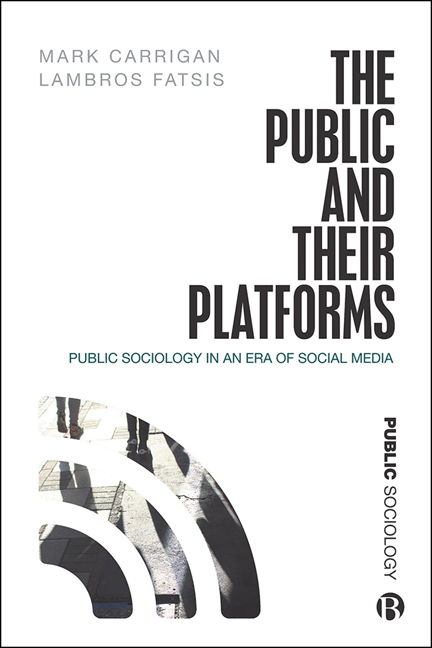Book contents
- Frontmatter
- Contents
- Acknowledgements
- Series Editors’ Preface
- Introduction
- 1 Defining ‘the Public’
- 2 The History of Platforms
- 3 Between Publics and Platforms
- 4 Sociology and its Platforms
- 5 The Past, Present and Future of Public Sociology
- 6 Making Sociology Public
- 7 Making Platforms Public
- 8 Assembling Public Sociology
- Notes
- References
- Index
2 - The History of Platforms
- Frontmatter
- Contents
- Acknowledgements
- Series Editors’ Preface
- Introduction
- 1 Defining ‘the Public’
- 2 The History of Platforms
- 3 Between Publics and Platforms
- 4 Sociology and its Platforms
- 5 The Past, Present and Future of Public Sociology
- 6 Making Sociology Public
- 7 Making Platforms Public
- 8 Assembling Public Sociology
- Notes
- References
- Index
Summary
To understand the emergence of digital platforms it can be helpful to look back through the history of the media in order to understand how new media technologies have always been embedded within a broader apparatus of technical developments. The materialist phenomenology of Couldry and Hepp (2018) conceives of a sequence of media systems, underwritten by technological advances with an array of interdependent effects. The broadcast media system emerged with electrification, the capacity of media to operate through electronic transmission (Couldry and Hepp 2018: loc 1299–1375). Numerous media emerged from this, ranging from the telegraph, through to telephony and broadcast media, with their own particular dynamics and effects. However, the capacities of the media system as a whole were defined by simultaneity in terms of public broadcast and personal communication. Exploiting these possibilities facilitated the growth of enormously influential media organizations, producing connectivity through shared patterns of experience grounded in their production cycles and control over the relatively unified attention space within a media system where broadcast capacity was only accessible to a few.
Under these conditions there was a relative scarcity of representations of publics in their own terms, ensuring the social visibility of those which did pass through the many filters in operation. Professional expertise meant representations of lives tended to be presented in appealing and engaging ways, filtered by professionals based on an expectation of what will win the attention of a general audience. Furthermore, the commercial imperative to ensure an audience means norms, genres and expectations will be shaped by the past experiences of these professionals and lessons learned from them. While more differentiation entered into the system in its later stages, as the number of television channels expanded and the audience for print media was increasingly segmented, the media system facilitated by electrification appears remarkably closed, particularly in terms of the representation of publics within it, in comparison to what has emerged with digitalization over the past three decades (Carrigan 2016, 2018). However, as Wu (2010: 214) points out, the fragmentation of audiences is the norm and their unification is the exception.
- Type
- Chapter
- Information
- The Public and their PlatformsPublic Sociology in an Era of Social Media, pp. 31 - 54Publisher: Bristol University PressPrint publication year: 2021



